Hello folks!!!
Here comes the best and the more simplistic though useful explanation about the equation of straight lines in Analytic Geometry, found at the web site Purple Math. I thought I should share it with all of you:
====================================================================
Given two points (x1, y1) and (x2, y2), the formula for the slope of the straight line going through these two points is:
The formula for slope is sometimes referred to as "rise over run", because the fraction consists of the "rise" (the change in y, going up or down) divided by the "run" (the change in x, going from left to the right). If you've ever done roofing, built a staircase, graded landscaping, or installed gutters or outflow piping, you've probably encountered this "rise over run" concept. The point is that slope tells you how much y is changing for every so much that x is changing. Pictures can be helpful, so let's look at the line y = ( 2/3 )x – 4; we'll compute the slope, and draw the line.
To find points from the line equation, we have to pick values for one of the variables, and then compute the corresponding value of the other variable. If, say, x = –3, then y = ( 2/3 )(–3) – 4 = –2 – 4 = –6, so the point (–3, –6) is on the line. If x = 0, then y = ( 2/3 )(0) – 4 = 0 – 4 = –4, so the point (0, –4)is on the line. Now that we have two points on the line, we can find the slope of that line from the slope formula:
Let's look at these two points on the graph: Copyright © Elizabeth Stapel 2000-2011 All Rights Reserved | 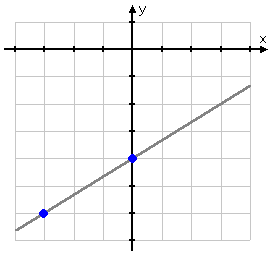 | |
In stair-stepping up from the first point to the second point, our "path" can be viewed as forming a right triangle: | 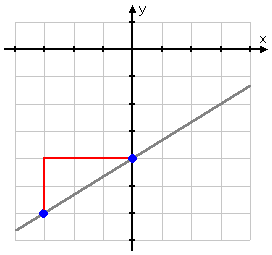 | |
| The distance between the y-values of the two points (that is, the height of the triangle) is the "y2 – y1" part of the slope formula. The distance between the x-values (that is, the length of the triangle) is the "x2 – x1" part of the slope formula. Note that the slope is 2/3, or "two over three". To go from the first point to the second, we went "two up and three over". This relationship between the slope of a line and pairs of points on that line is always true. | ||
To get to the "next" point, we can go up another two (to y = –2), and over to the right another three (to x = 3): With these three points, we can graph the liney = ( 2/3 )x – 4. | 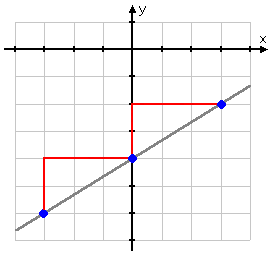 | |
Let's try another line equation: y = –2x + 3. We've learned that the number on x is the slope, so m
= –2 for this line. If, say, x = 0, then y = –2(0) + 3 = 0 + 3 = 3. Then the point (0, 3) is on the line. With this information, we can find more points on the line. First, though, you might want to convert the slope value to fractional form, so you can more easily do the "up and over" thing. Any number is a fraction if you put it over "1", so, in this case, it is more useful to say that the slope is m = –2/1. That means that we will be going "down two and over one" for each new point.
We'll start at the point we found above, and then go down two and over one to get to the next point: |  | |
| Go down another two, and over another one, to get to the "next" point on y = –2x + 3: | 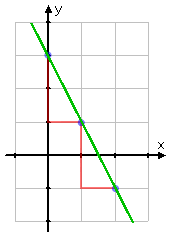 |
Given a point on the line, you can use the slope to get to the "next" point by counting "so many up or down, and then so many over to the right". But how do you find your first point? Take a look back at thegraph of the first line and its equation: y = ( 2/3 )x – 4 crossed the y-axis at y = –4, so the equation gave us the y-intercept. The second line did too: the graph of y = –2x + 3 crossed the y-axis at y = 3. This relationship always holds true: in y = mx + b, "b" gives the y-intercept, and "m" is the slope. We can use this fact to easily graph straight lines:
- Graph the equation y = ( 3/5 ) x – 2 from the slope and y-intercept. From the equation, I know that the slope is m = 3/5, and that the line crosses the y-axis aty = –2. Copyright © Elizabeth Stapel 2000-2011 All Rights Reserved
I'll start by plotting this first point: | 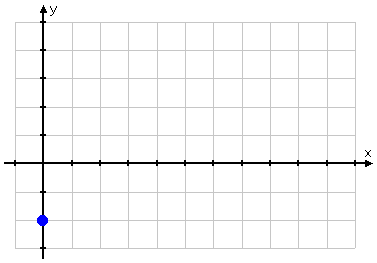 | |
From this point, I go up three and over five: | 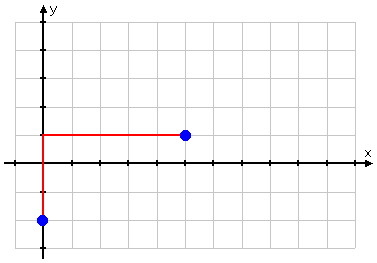 | |
Then I go up another three and over another five to get my third point: | 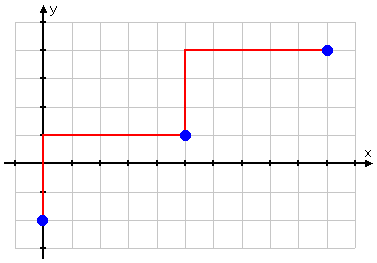 | |
With three points, I can draw my line: | 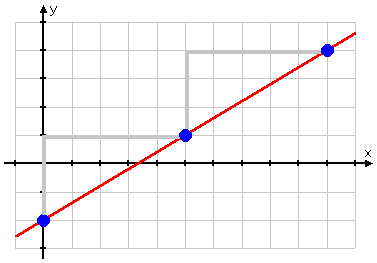 |
====================================================================
My comments:
----------------------------------------------
I don't think my first explanation of the subject was bad at all back to 1999, but this one is so concise and yet useful, it's crystal clear to me and served as a nice review on the subject. Thanks Purple Math!
----------------------------------------------
Source: http://www.purplemath.com/modules/slopgrph.htm
No comments:
Post a Comment